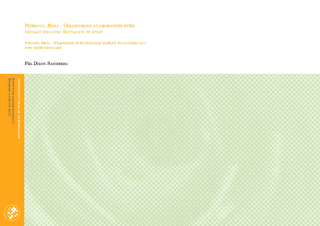| dc.description.abstract | Masteroppgaven tar for seg utviklingen av en ny bydel på nedlagte Peterson
Paper sitt område i Moss sentrum. Området har en industrihistorie som
strekker seg over 300 år tilbake i tid. Som i mange andre byer i vesten er
produksjonsindustrien lagt ned de siste årene og i 2012 var også driften for
papirfabrikken over.
Oppgaven tar for seg den sørlige delen av Peterson-tomta - det viktige
koblingspunktet mellom eksisterende sentrum og den nye bydelen. Det
er her ”invitasjonen” inn til den nye bydelen skal formes i et industrielt og
historisk viktig elvelandskap. Prosjektområdet er ca. 500m langt og 100m
bredt. Fokus i oppgaven har vært å skape rammer for sosialt liv. I det
ligger å skape gode bevegelseslinjer og oppholdsrom i byen som tilbyr en
attraksjon og funksjon som inviterer til bruk - også i hverdagslivet.
Det er utført stedsanalyser for området og det er sett på eksisterende og
potensielle forbindelseslinjer mellom dagens sentrum og den kommende
bydelen. Relevant litteratur er studert, samt referanseprosjekter der
industriell sjøfront er urbanisert. Tilslutt er det prosjektert et løsningsforslag.
Forslaget deler opp prosjektområdet i 4 ulike byrom. Ett har fokus på
fortetting og nybygg for å få nye funksjoner og brukere til stedet. Det
neste er en flerbruksplass som skal fungere som en fleksibel og urban
hybrid mellom torg og park, med eksisterende industribygg som ramme.
Tredje rom er et trafikalt knutepunkt med ny forbindelse over elven for
alle trafikanter samt gjenbruk av dagens jernbanetrasé til sykkelvei, som
forbinder sentrum på langs. I det fjerde rommet, nederst mot sjøen,
danner nybygg langs kaien en bakvegg for en raust utformet strandpark.
Alle rommene grenser til Mosseelva og har industrihistorien som en rød
tråd som binder dem sammen til et helhetlig offentlig byrom, med 4 nye
broforbindelser til sentrum. De er alle designet på et overordnet nivå med
enkelte innslag av detaljer for å vise materialbruk, plantevalg og romlighet i
en menneskelig målestokk. The subject for this master degree thesis is the development of a new urban area on the site of a previous paper production plant (Peterson Paper) in the centre of Moss, Norway. The area has a history of industrial production extending over the last 300 years. Just as in many other towns in western Europe, there has been a decline in industrial production, and year 2012 brought closure for the town’s paper mill.
The thesis concentrates on the southern part of the Peterson site – the key point of connection between the existing town centre and the new town development area. It is at this point, in the significant historical and industrial river landscape, where the ’invitation’ to a new part of town is to take form. The project area is approximately 500m in length and 100m in breadth. Focus in the thesis is to create a framework for social aspects of town development. This involves creating optimal spaces for people to move and spend time in, as a strategy for generating sustainable urban living in the town centre.
Area surveys have been made for the site and both existing and potential lines of communication between the present town centre and the future new urban area have been examined. Relevant literature and similar projects where an industrial seafront has been urbanised have been studied. As a conclusion, a suggested solution has been made. The solution divides the project area into 4 different urban spaces. One is focused on densification and new buildings to make room for new functions and new users of the space. The next space is a multifunctional area which has to work as a flexible and urban hybrid between market place and park, and which is framed in by existing industrial buildings. The third space is a meeting point for various forms of transport, with a new connection across the river for all travellers, as well as recycling the present railway line as a cycle path to join the whole centre area together. In the fourth space, nearest to the sea, new buildings create a back wall for a generously designed park for bathing and recreation. All the spaces are next to ”Mosseelva” and have industrial history as a binding element to create a complete public urban space, with 4 new bridge connections to the present town centre. They are all designed on an overall scale, with certain details presented in order to show use of materials, choice of plants and design at a human scale. | no_NO |
